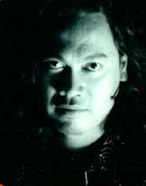 |
||
|---|---|---|
| CP Foundation | About CP Biennale | 2003 | 2005 | Contact Us | >||
           
|
||
|
Fadjar Djunaedi has been doing this for a long time. The artist has been exploring daily activities as subjects for his paintings. Fadjar's home environment, still strongly communal, has apparently sharpened his sensibility for simple, natural, and honest ways of life. It does not mean, however, that his works are simple. On the contrary, they are done quite intricately and in many layers. Fadjar's visual idioms are present in a unique way. He deforms the human shape by disproportionately enlarging and compressing parts of the body. The result is a new form that bears the image of a "big guy." The finding of such new form, which can indeed seem comical, is initially inspired by the picture of Ade Rai's body--Ade Rai being a famous Indonesian body builder--in Tabloid Bola, a sport tabloid Fadjar often reads. Although the shape deformations have nothing to do with the trinity of the shape portrayed, the meaning behind the shape, and the actual reality, one can still find the relations among these three matters in Fadjar's paintings. However, Fadjar is actually painting merely to find the right visual idioms that will enable him to express his thoughts about the daily life. With his unique imagery of the deformed bodies, one can sense the humor, the parody, and the comic in his paintings. Fadjar's works, therefore, appear to be witty and critical. See the painting In Trouble (2003). How funny the picture looks! A man with a large head looks terrified as a dog is chasing him, and the dog manages to bite off parts of his trousers. We can read this picture in various ways. We can, if we want, interpret the dog as the people, and the terrified man as the power-holders. The picture can therefore mean how the people are angry and demanding their just share to the power-holders, who have often robbed them. But, once again, Fadjar does not actually want to say as much. He merely wants to paint the picture, without any political meanings. He wants to portray exactly the simplicities of life. Such simplicity can also be seen in the painting Experiment (2003). A heavily built man is comically playing with a mouse, dipping the poor animal into a yellow glass, so that the mouse's head becomes yellow as well. We are then free to interpret this painting. Let us say, for example, that the man represents the power of the people, and the mouse represents the person who has been eating up the people's money. The painting can therefore mean that the people are catching the corrupt official, and after a close inspection, find out that the official is from the "yellow party." Indeed, Fadjar visual idioms are focused on the shapes and the movements of the body. The background remains empty but still in unity with the scenes he is depicting. At the end, Fadjar finds effective and unique visual idioms that becomes so characteristic of him; one that goes hand-in-hand with his tendency to see his fellow humans with a sense of humor. Djuli Jati Prambudi Born on June 7, 1970 in Batu, Malang, East Java. SELECTED GROUP EXHIBITIONS |
||
|
CP Foundation | About CP Biennale | 2003 | 2005 | Contact Us
Jl. Suryopranoto 67A, Jakarta 10160, Indonesia. ph. +62.21.3448126, 3853206 | fax. +62.21.3853203, 3853208 info@cp-foundation.org |
||
 Scenes of someone being assaulted by mosquitoes, a person being attacked by a dog, babies wetting their bed... these are all settings of life we can see everyday--what is so special about them? But it is another matter when the simple actions, the daily acts--natural, spontaneous, and honest as they are--appear on the canvas with a mesmerizing visual language. Viewers are then asked to have a dialogue with such simple and common things, amidst the ubiquitous nonsense, dishonesty, and political babbles.
Scenes of someone being assaulted by mosquitoes, a person being attacked by a dog, babies wetting their bed... these are all settings of life we can see everyday--what is so special about them? But it is another matter when the simple actions, the daily acts--natural, spontaneous, and honest as they are--appear on the canvas with a mesmerizing visual language. Viewers are then asked to have a dialogue with such simple and common things, amidst the ubiquitous nonsense, dishonesty, and political babbles.